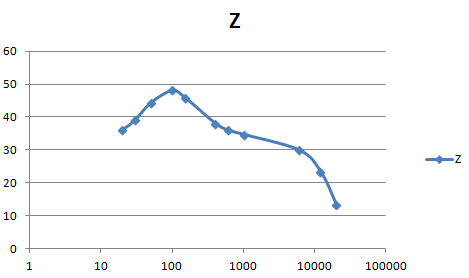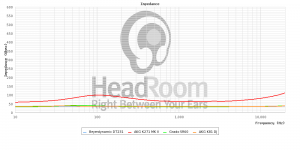My questions-
Would you say that any commercial headphones or earphones rated as 32 Ohm almost without exception stay within say + or - 20% of rated impedance at any frequency within the frequency handling range, or is the opposite the case?
Having developed a passive cross-feed network (read a collection of resistors and capacitors connected between an amp and pair of headphones), the impedance of the headphones remaining fairly constant at all frequencies is necessary in order for the correct crossing over to occur. I'd like to be able to say that at least almost all headphones rated 32 Ohm will work properly with the network, but I haven't been able to get any really solid information about this issue. NWAVGuy sort of gives an answer.
Any help is appreciated,
cT
Would you say that any commercial headphones or earphones rated as 32 Ohm almost without exception stay within say + or - 20% of rated impedance at any frequency within the frequency handling range, or is the opposite the case?
Having developed a passive cross-feed network (read a collection of resistors and capacitors connected between an amp and pair of headphones), the impedance of the headphones remaining fairly constant at all frequencies is necessary in order for the correct crossing over to occur. I'd like to be able to say that at least almost all headphones rated 32 Ohm will work properly with the network, but I haven't been able to get any really solid information about this issue. NWAVGuy sort of gives an answer.
Any help is appreciated,
cT
Tyll Herstens could be your friend
look up the company he started Headfi.com, tech section - "build a graph" Learning Center - Build a Headphone Graph | HeadRoom Audio
and his current InnerFidelity posts, measurements
Headphone Buyers Guide | InnerFidelity
look up the company he started Headfi.com, tech section - "build a graph" Learning Center - Build a Headphone Graph | HeadRoom Audio
and his current InnerFidelity posts, measurements
Headphone Buyers Guide | InnerFidelity
It's probably safer to assume they are within +/-50% or worse. Here is the impedance vs freq of my Audio Technica ATH-AD900:

If the filter needs to be accurate with a wide range of headphones, it is better to implement it actively.
Thanks for the input,
Except for the (resonant?) peak at 100 Hz, that graph doesn't look too bad, considering that relative audio intensity in frequencies > 10 kHz is much less.
A survey of the impedance Vs. frequency characteristics of current 32 Ohm headphones is I suppose what I'm after; I certainly would hope that that isn't something I would have to do myself!
Regards,
cT
Tyll Herstens could be your friend
look up the company he started Headfi.com, tech section - "build a graph" Learning Center - Build a Headphone Graph | HeadRoom Audio
and his current InnerFidelity posts, measurements
Headphone Buyers Guide | InnerFidelity
jcx,
Thanks for those links; I'll take a look.
For anyone else interested, I did find the blog at the below URL fairly informative:
http://nwavguy.com.blogspot/2011/02/headphone-impedance-explained.html
For anyone interested, I did a quick survey of four headphones specified as 32 Ohm: Beyerdynamic DT232, AKG K 271, AKG K81 DJ, and Grado SR 60. Attached is a Headroom graph of Impedance W.R.T. frequency. Thanks again to jcx for the link to Headroom's "Build a Graph".
Regards,
cT
Regards,
cT
Attachments
most headphones are single driver so will just have a bass mass/spring reasonance peak, possibly some visible Z rise from inductance at high freqeuncy
and many may simply have so much R and such low electromechanical coupling that they are nearly flat with frequency - Orthodynamics are commonly very flat Z
but there are multidriver headphones - some pricey iem in particular - they can have several peaks/dips spread over the audio spectrum
and many may simply have so much R and such low electromechanical coupling that they are nearly flat with frequency - Orthodynamics are commonly very flat Z
but there are multidriver headphones - some pricey iem in particular - they can have several peaks/dips spread over the audio spectrum
Last edited:
Here are some more critical examples.

Crossfeed is something best implemented somewhere in an amplifier or in software. Jan Meier put his in between two gain stages but basically you can do this at line level as well (with higher impedances).

Crossfeed is something best implemented somewhere in an amplifier or in software. Jan Meier put his in between two gain stages but basically you can do this at line level as well (with higher impedances).
Crossfeed is something best implemented somewhere in an amplifier or in software. Jan Meier put his in between two gain stages but basically you can do this at line level as well (with higher impedances).
Yes, TMM has made a similar comment in regards to active being better. The advantages of the (passive) network are (1) low cost- it's made up of just resistors and capacitors, (2) small size, (3) doesn't need a battery, and (4) relatively more simple circuit design.
Using opamps, making it an active design wouldn't make it terribly more complex. But then it needs a battery holder and power switch, and the whole thing becomes a bit more complex and time consuming to diy.
Plus there is more challenge of being able to implement something that works successfully without resorting to an active device.
Regards,
cT
Plan B is to connect a 10 Ohm resistor in parallel with the headphone and call it an 8 Ohm headphone. That'll flatten out the impedance curve nicely, but a lot of modern headphone amps won't like it.
edit: A passive network between source and headphone amp may be the best bet, if you want to avoid active circuitry.
edit: A passive network between source and headphone amp may be the best bet, if you want to avoid active circuitry.
Last edited:
Plan B is to connect a 10 Ohm resistor in parallel with the headphone and call it an 8 Ohm headphone. That'll flatten out the impedance curve nicely, but a lot of modern headphone amps won't like it.
As I would like the network to be compatible with the typical low-wattage battery-powered amplifiers found in portable players, that won't work. Otherwise Plan B might be an option.
edit: A passive network between source and headphone amp may be the best bet, if you want to avoid active circuitry.
That seems like a better proposal. If my minimalist approach doesn't pan out, then that is probably what I will do. Thanks.
My network includes a 39 Ohm resistor in-series with each headphone. Assume a 32 Ohm nominal headphone resistance RL (treating what is actually impedance as pure resistance) in-series with the 39 Ohm resistor.
If resistance of RL is increased to 64 Ohm, then by the change to voltage division the voltage drop across RL, Vrl, increases by 2.8 dB. An increase of 2.8 dB is less than perfect, but possibly acceptable.
If RL is decreased to 16 Ohm, then Vrl decreases by 3.8 dB. That is a bit too much, but on the other hand, a decrease of impedance by one-half is much less likely than a doubling of impedance.
So although a flat headphone impedance characteristic(as a function of frequency) is much more desireable, I think that some variation of headphone impedance might not cause my network to contribute too much distortion.
Regards,
cT
- Status
- This old topic is closed. If you want to reopen this topic, contact a moderator using the "Report Post" button.
- Home
- Amplifiers
- Headphone Systems
- 32 Ohm- actual impedance at diff. frequencies?
